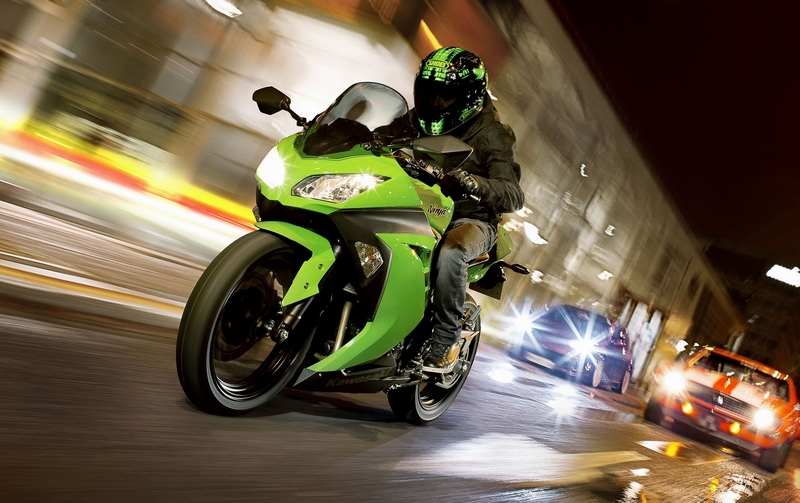BMW G 310 GS – Launch Report
Following the release of the G 310 R road bike, BMW continues its march into the sub 500cc segment with the eagerly anticipated BMW G 310 GS. Yes, a baby GS. Uzair Abdul-Karrim rode it on gravel and tar roads in the Knysna area to find out just how much of a ‘GS’ it is.
Looks and Features
When seeing it in the flesh, it’s clear the design team have put huge effort into this bike. With the high front fender, tall stance and short rear end, it is instantly recognisable as a BMW GS model. While obviously not a big bike, it doesn’t look diminutive. All in all, it’s a handsome machine, especially in white with red, blue and silver accents.

This junior GS shares its engine with the BMW G 310 R. That means a 313 cc single-cylinder motor, producing 25 kW of power and and 28 Nm of torque. Those aren’t big numbers, but coupled with a claimed weight of just 169.5 kg, it’s keen, with smooth and predictable power delivery.
The G 310 GS is fitted with 41 mm upside-down forks out front and an adjustable mono-shock at the rear, both providing wheel travel of a respectable 180 mm. Being a BMW, ABS brakes is a standard feature.

Turn the key and you are greeted by a fully digital monochrome instrument display, which shows all the necessary information clearly. There is an immediate impression of solidity, which is something I didn’t expect from a bike of this size. The handle bars are wide, providing plenty of leverage along with comfort. There is also an ‘ABS’ button handily located on the left-hand side of the handlebars, allowing the rider to easily deactivate ABS to the rear wheel for dirt riding.
A seat height of 835 mm means shorter riders (such as myself) needn’t make fools of themselves when getting on and off. It makes the bikes more approachable to people that are new to adventure riding or riding in general. It is an easy step into the ‘GS’ family.

On the Move
We started off on dirt, with which I have zero talent. The tracks we kept to were mostly gravel, with nothing too rocky or technical (thankfully). This terrain is what the G 310 GS is meant for. BMW calls it “light off-roading”.
The junior GS is equipped with a 19-inch front wheel, to help with off-road conditions, yet the wheels are alloys rather than spoked, proving that the bike wasn’t designed for enduro type riding. What I can say, is that I didn’t fall off at all, and actually ended up having quite a bit of fun. Really, the low weight, punchy motor and suspension set-up make this a pretty simple bike to handle on gravel, even for a complete novice.

Out on the road, other characteristics become clear. What I noticed first was how plush the ride felt, with a smoothness I’ve never felt in a bike of this capacity. The handling is mostly sure footed, but in faster corners the front end can be vague, which doesn’t lend confidence. However, pushing on, it really is a stable bike.
Through twisty mountain roads and tight turns the G 310 GS is a riot. At motorway speeds, it is less pleasant and vibrates merrily at 120 km/h, though this isn’t unbearable. The small screen provides average wind protection, but you’re never really travelling fast enough to require anything more. It really shines in and around town, as the weight makes it easy to handle, the low gearing means you’re never lacking for power, and the high seating position makes it easy to see over traffic.

Rivals
A small capacity BMW adventure bike, costing R79 650, would have seemed far fetched a few years ago. Yet this is a new and growing segment. The G310GS will come up against the Honda CRF 250 Rally, which is far superior as an off-road machine, and the Kawasaki Versys-X 300, which is as much of an all rounder, but maybe a better tourer than the BMW.
The G 310 GS’s biggest rival is the slightly cheaper G 310 R roadster. It is far more involving and entertaining on tar, and it also carries the BMW badge on its tank. So unless you are definitely going to do some gravel riding, or absolutely must have a GS badged bike, then there already is a small BMW for you.
The Specs
313cc single-cylinder, four stroke
25 kW (34hp) @ 9 500 rpm
28 Nm @ 7 500 rpm
Dry weight: 169.5 kg
Fuel tank: 11 litres
Fuel consumption: 3.3 l/100km (claimed)




